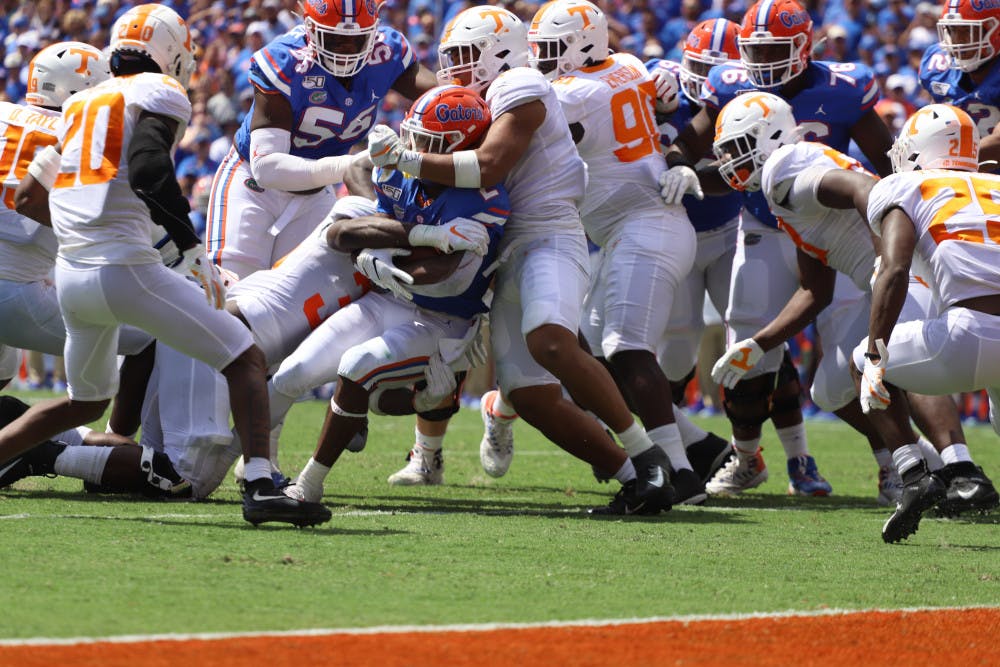There weren’t many aspects to criticize about the 2019 Gators. A second-straight double-digit win season, a win in a New Year’s Six bowl for the second year in a row and blowout wins over rivals Tennessee and Florida State is usually enough to please a fanbase.
But the Gators’ offensive Achilles’ heel was pretty obvious.
After rushing for over 210 yards per game in 2018, Florida had 130 last season. The Gators had just 4.24 yards per carry in 2019 compared to 5.3 the year prior. UF’s running game went from a strength in 2018 to a detriment in 2019.
The reality is that Florida’s running game was not only bad by its own standards, but it was also terrible by Power 5 standards.
I’m going to look at three things: Expected Points Added (EPA) per rush, success rate and stuffed rate.
EPA per rush: Think of this as how much a play is worth compared to what was expected. EPA per play helps solve the problem of not all yards being equal. For example, Lamical Perine might run for four yards on one carry and eight on another, but if the four-yard carry came on 3rd and 1 and the eight-yard carry is on 3rd and a mile, the four-yard carry is obviously more valuable.
Success rate: This is what percentage of plays result in a positive EPA. In this instance, we’re looking for the percentage of running plays that were ultimately a “successful” play for the offense.
Stuffed rate: This is what percentage of running plays ended at or behind the line of scrimmage, or how many times the running back was “stuffed.”
With that settled, let’s look at how Power 5 teams performed when they ran the ball.
This table shows how well Power 5 teams ran the ball based on our three metrics. Red numbers indicate that a team is one of the worst 16 teams, yellow is the next 16, then green and then teams in blue are the top 16.

Based on this table alone, it’s easy to see that the Gators were awful at running the ball: They were in the bottom 16 in all three categories and in the bottom 10 in stuffed rate and success rate.
Not great.
My objective here is not to just show how bad the Gators were at running the ball, because anyone who watched them last season knows that. Instead, let’s try to find a scenario where Florida was good—or at least passable—at running the ball.
Let’s start in the red zone. UF’s red-zone offense was decent last season, finishing 59th in the country red zone scoring percentage (.852). It also had 15 rushing touchdowns in the red zone, so one could assume it was pretty good at running the ball deep in enemy territory.

Never mind.
The Gators’ EPA per rush in the red zone was the third-lowest in the Power 5. Only a Georgia Tech team that is undergoing a painful transition from the triple option and the dumpster fire in the panhandle that was FSU last season were worse than the Gators in EPA per rush.
Weirdly enough, for as much as Florida eagerly abandoned the running game midseason, it doubled down on running the ball in the red zone. UF ran the ball 50 times in the red zone, the 18th-most in the Power 5. It seems perplexing, and that combined with coach Dan Mullen’s willingness to go for it on fourth down near the end zone might be why Florida was only 59th in red zone scoring percentage.
Let’s look at another situation. Mullen is renowned for his second-half adjustments, which paid off immensely for the Gators in 2019. Florida was 14th in the country in second-half scoring with 17.5 points per game.
That did not mean that UF was a second-half rushing team, though.

Compared to the rest of the Power 5, Florida still wasn’t great, but it did inch closer toward breaking even from an EPA per rush standpoint.
More worrying is UF’s incredibly low success rate of 29.3 percent, the second-lowest in the Power 5. The low success rate despite a mediocre EPA per rush might lend some credence to the idea that the Gators’ running game was pretty terrible with a few big plays. Those plays would boost an otherwise pedestrian EPA per rush while not affecting a team’s success rate much. In other words, the Gators only had a handful of big running plays across an entire season’s worth of carries in the second half and were pretty bad outside of those plays.
Some of Florida’s biggest and most memorable plays last season were running plays. Perine’s 88-yard touchdown against Auburn. Receiver Josh Hammond’s end-around to ice the game against Kentucky. Running back Dameon Pierce’s 75-yard touchdown against South Carolina. All of these are probably among the first plays Gators fans think about from last season.
So let’s take a look at which teams had big rushing plays and how often they had them.

They didn’t happen very often, but when the Gators had an explosive running play, they made it count. Florida’s nine explosive rushing plays had an EPA per rush of 3.55, the fourth-highest in the Power 5.
That’s the one thing the Gators were good at when it came to running the ball last season. Granted, that’s nine out of 244 non-garbage-time carries, but Florida’s running game did produce several big plays when it was desperately needed.
That doesn’t excuse UF’s struggles in the running game elsewhere, but it does show that there were a few times when the Gators’ rushing attack actually had some attack in it.
Follow Brendan Farrell on Twitter @Bfarrell727 and contact him at bfarrell@alligator.org






